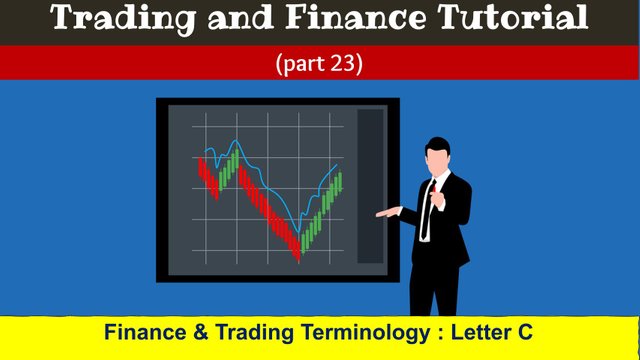Basics of Trading and Finance (Part 23) : Trading and Finance Terminology : C (41-70)
Intro
IntroAs a moderator of the Tron Fan Club community, I regularly write various tutorials on crypto blockchain and Tron related matters. The main purpose of these tutorials is to make our new users aware of these topics. In continuation of that I am writing tutorials on trading and finance. Hope you can easily learn some details of trading and finance through this tutorial series.

Trading can seem scary if you don't understand it well. That’s why I bring you simple tutorials to help you enter the trading world step by step. Any trading involves buyers and sellers, a marketplace, prices, and exchange rates. Today, let's learn some important trading terms starting with the letter "C." I’ll explain them in a simple way with examples.
41. Call Option
A call option gives the buyer the right, but not the obligation, to buy an asset at a specific price within a certain time. For example, if you think Bitcoin's price will go up, you can buy a call option to profit from the increase.
42. Candlesticks
Candlesticks are a type of chart that shows price movements over time. They have four parts—open, close, high, and low. If the closing price is higher than the opening price, the candlestick is green, showing an uptrend.
43. Capital Market
The capital market is where companies raise money by selling stocks and bonds to investors. For example, when a company needs funds to expand, it issues shares in the capital market.
44. CeFi (Centralized Finance)
CeFi refers to financial services provided by centralized companies, like Binance or Coinbase, where a central authority controls your funds and transactions.
45. Censorship
Censorship happens when access to financial services is restricted or controlled by an authority. In crypto, decentralization helps avoid censorship.
46. Charts
Charts visually represent price movements and trends. Traders use charts to analyze patterns and make decisions.
47. Circulating Supply
This is the number of coins or tokens available in the market. For example, Bitcoin has a circulating supply of around 19 million coins.
48. Closing Price
The closing price is the final price of an asset at the end of a trading session. If Bitcoin closes at $50,000 today, that’s the closing price.
49. Cloud Mining
Cloud mining allows you to mine cryptocurrencies without owning hardware. You rent mining power from companies online.
50. Coin
A coin is a digital currency that operates on its blockchain, like Bitcoin or Ethereum.
51. Coinbase
Coinbase is a popular crypto exchange where users can buy, sell, and store cryptocurrencies easily.
52. Cold Storage
Cold storage refers to keeping cryptocurrencies offline to protect them from hacking. A USB drive can be used for cold storage.
53. Cold Wallet
A cold wallet is a device or tool that stores crypto offline, providing higher security than online wallets.
54. Collateral
Collateral is an asset pledged as security for a loan. For example, in crypto, you can use Bitcoin as collateral to borrow stablecoins.
55. Consensus
Consensus is an agreement among network participants on the validity of transactions. Proof of Work and Proof of Stake are common consensus methods.
56. Consortium Blockchain
A consortium blockchain is a private blockchain managed by a group of organizations instead of a single entity.
57. Contract
A contract in trading is an agreement between buyers and sellers to trade an asset at a specific price. Futures contracts are common in crypto.
58. Convergence
Convergence happens when the prices of different markets come closer over time.
59. CPI (Consumer Price Index)
CPI measures the average change in prices of goods and services. It helps track inflation.
60. CPU Miner
A CPU miner uses a computer's processor to mine cryptocurrencies, though it's not as efficient as specialized hardware.
61. Credit
Credit is borrowed money that must be repaid later with interest. Credit cards are a common example.
62. Credit Margin
Credit margin is the extra amount of funds a borrower needs to maintain in their account when taking a loan.
63. Credit Rating
Credit rating evaluates a borrower’s ability to repay debt. Higher ratings mean lower risk.
64. Credit Risk
Credit risk is the chance that a borrower might not repay a loan. Lenders check credit scores to reduce this risk.
65. Cross Rate
A cross rate is the exchange rate between two currencies that don’t involve the local currency. For example, EUR/JPY is a cross rate if you're in the U.S.
66. Crowdfunding
Crowdfunding is when many people contribute small amounts of money to fund a project, often through online platforms.
67. Crypto
Crypto is a short form of cryptocurrency, which is a digital currency that uses blockchain technology.
68. Cryptocurrency
Cryptocurrency is a digital or virtual currency that works without a central authority, like Bitcoin and Ethereum.
69. Cryptography
Cryptography is a technique used to secure information using codes and encryption in blockchain technology.
70. Currency
Currency is a medium of exchange used to buy goods and services, such as the U.S. dollar or Bitcoin.
These were some basic trading and finance terms starting with "C." Understanding them will help you navigate the trading world with confidence. Keep learning and stay tuned for more tutorials. See you in next part with the words starting with D.


Click to Join our Discord Server
Upvoted! Thank you for supporting witness @jswit.
I am a trader myself but I have read some of these terms for the first time, probably because I have not used them but it is important to learn all this. Thank you for this informative blog! : )
Thank you very much for your appreciating comment
0.00 SBD,
0.00 STEEM,
0.00 SP